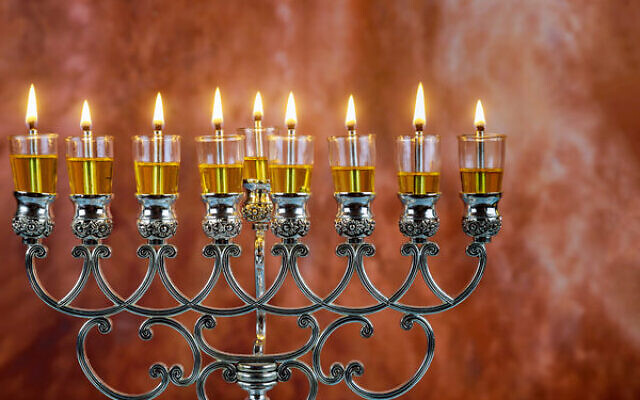Global Chanukah traditions
From bonfires to hanging chanukiahs to an extra candle, here are some lesser-known Jewish Chanukah traditions from all over the globe.
Many of the most well-known Chanukah traditions are universal. Whether you’re in Argentina or Zimbabwe, Jews will mark the eight-day festival by lighting a chanukiah, eating fried foods and recounting the victorious story of the Maccabees and the restoration of the Temple in Jerusalem.
But Jews around the world have also developed Chanukah customs that are unique to their local community. For example, while jam-filled doughnuts (sufganiyot) are a mainstay among Ashkenazi Jews, Chanukah in southern India is celebrated by making gulab jamnun, a milk-based ball of dough that is deep fried and then drenched in sugar syrup. The sweet treat is also consumed by non-Jewish Indians during other celebrations like Diwali.
Indian Jews enjoying gulab jamnun is far from the only example of a distinct tradition that a community has developed in the Diaspora. Here are six more customs that go beyond playing dreidel or giving Chanukah gelt.
1. Hanging the chanukiah on the wall
Most Ashkenazi Jews place a menorah in the window in order to publicise the miracle of Chanukah. In Morocco, Algeria and other North African communities, it is customary to hang the chanukiah on a hook in the doorway, beside the mezuzah. Putting the menorah near the mezuzah was thought to enhance the protection already offered by the mezuzah. If you look at menorahs made in North Africa, you will notice that many have a ring at the top, as well as a flat metal backing, so that the menorah could be safely hung.
2. Constructing a chanukiah from potatoes
Jews in Romania, as well as Austria and other central European communities, would scrape out potatoes, filling each potato space with oil and a wick to serve as the chanukiah. Rather than putting all eight out at once, each day they would add another potato. While the origin of this custom is unclear, it likely came about due to economic struggles.
3. Lighting an extra shamash
The Jewish community of Aleppo, which comprised mostly Sephardi Jews who had escaped the Inquisition, lit an extra shamash on each night of Chanukah. Several explanations exist — some say that the second shamash was meant to honour God and acknowledge the divine intervention that brought them to safety. Others say the custom was a nod toward the non-Jews of Aleppo, who welcomed them as refugees.
4. Glass boxes on display
Before mass immigration and the establishment of the State of Israel in the 20th century, Jews lived in Jerusalem for centuries and followed the ruling that the chanukiah’s lights needed to be placed outside the home for all to see.
However, Jerusalem winters are often wet and windy, so the community began crafting aquarium-like glass boxes to protect their flames. Inside, Jerusalem Jews put small cups of olive oil and lit a wick to correspond with each night. Some of Jerusalem’s oldest homes even have a shelf carved out of the home’s exterior walls to place the glass boxes in.
Today, many Israeli Jews have adopted this practice, although some will simply place a chanukiah with candles inside the box, rather than using oil.
5. Chag habanot: a celebration of women
Jewish communities in Libya, Tunisia, Algeria, Iraq, Iran, Turkey, Morocco, Greece and Yemen celebrate another holiday during Chanukah, known in Judeo-Arabic as Eid Al Bnat or Chag HaBanot in Hebrew, both of which translate to the Festival of the Daughters.
Observed on Rosh Chodesh Tevet (which falls on the sixth night of Chanukah), the girls and women of the community refrain from work and gather to recall Jewish heroines, particularly Judith, the Jewish woman who lived during the time of the Maccabees and helped prevent the impending siege of Jerusalem by decapitating the invading Assyrian general.
Chag HaBanot festivities vary from community to community, but often include eating sweets and fried treats, dancing, visiting the synagogue to kiss the Torah scrolls and singing well into the night. Girls approaching bat mitzvah age, as well as women who were engaged, were also publicly celebrated during Chag HaBanot.
6. Neighbourhood wine tastings
The region of Avignon, located in southern France, is renowned for its wineries. During the Saturday night that falls during Chanukah, after Shabbat ended, the Jews of Avignon open a new bottle of local wine in their homes and make a toast. Then, each family travels around their neighbourhood to taste the wines chosen by their neighbours and to toast to the miracle of Chanukah.
7. No melachot Near the chanukiah
It is a longstanding practice among North African and Middle Eastern Jewish communities, as well as Haredi Ashkenazi Jews, that as long as the chanukiah is lit, women refrain from doing melachot, the types of work that are forbidden on Shabbat and holidays. While Chanukah is not a holiday that requires Jews to refrain from labour, this custom can be traced back to laws codified by both Ashkenazi and Sephardic leaders who ruled, pre-electricity, that the light of the chanukiah was not to be used for anything besides enjoying the holiday.
8. The ninth night of Chanukah
In some parts of Morocco, Jewish children spend the last day of Chanukah going from house to house to collect the leftover cotton wicks that Moroccan Jews used in place of candles. At sundown, the wicks are ignited to create a large bonfire, and each community gathers to sing, dance and even leap over the fire, which was believed to bring good luck to the jumper, especially to women seeking a partner or struggling to conceive.
My Jewish Learning


comments